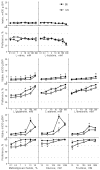Amino acid and carbohydrate preferences in C57BL/6ByJ and 129P3/J mice
- PMID: 17764708
- PMCID: PMC2235816
- DOI: 10.1016/j.physbeh.2007.07.016
Amino acid and carbohydrate preferences in C57BL/6ByJ and 129P3/J mice
Abstract
Compared with mice from the 129P3/J (129) inbred strain, mice from the C57BL/6ByJ (B6) inbred strain have higher consumption of several sweet-tasting amino acids and carbohydrates. To examine the relative contribution of taste and nutritive properties in these strain differences, we measured responses of B6 and 129 mice to eight sweet and non-sweet amino acids and carbohydrates in two-bottle preference tests with water. Mice from the two strains did not differ in consumption of non-sweet l-valine and l-histidine. Compared with 129 mice, B6 mice had higher consumption and lower preference thresholds for sweet amino acids l-glutamine, l-alanine and l-threonine, monosaccharides glucose and fructose, and maltooligosaccharide. These data suggest that differences in gustatory responsiveness are an important factor underlying higher consumption of some amino acids and carbohydrates by B6 mice compared with 129 mice. It is likely that in B6 mice, higher sweet taste responsiveness results in increased consumption of sweet-tasting amino acids and sugars, and higher taste responsiveness to complex carbohydrates results in increased consumption of maltooligosaccharide. However, postingestive processes also influence nutrient consumption and may be responsible for higher intake of carbohydrates compared with sweet-tasting amino acids. Results of this study set the stage for genetic analysis of differences between B6 and 129 mice in taste responsiveness and macronutrient consumption.
Figures
References
-
- Belknap JK, Crabbe JC, Young ER. Voluntary consumption of ethanol in 15 inbred mouse strains. Psychopharmacology (Berl) 1993;112:503–10. - PubMed
-
- Capeless CG, Whitney G. The genetic basis of preference for sweet substances among inbred strains of mice: Preference ratio phenotypes and the alleles of the Sac and dpa loci. Chem. Senses. 1995;20:291–298. - PubMed
-
- Lush IE. The genetics of tasting in mice. VI. Saccharin, acesulfame, dulcin and sucrose. Genet Res. 1989;53:95–99. - PubMed
-
- Kotlus BS, Blizard DA. Measuring gustatory variation in mice: A short-term fluid-intake test. Physiol Behav. 1998;64:37–47. - PubMed
Publication types
MeSH terms
Substances
Grants and funding
LinkOut - more resources
Full Text Sources
Medical


